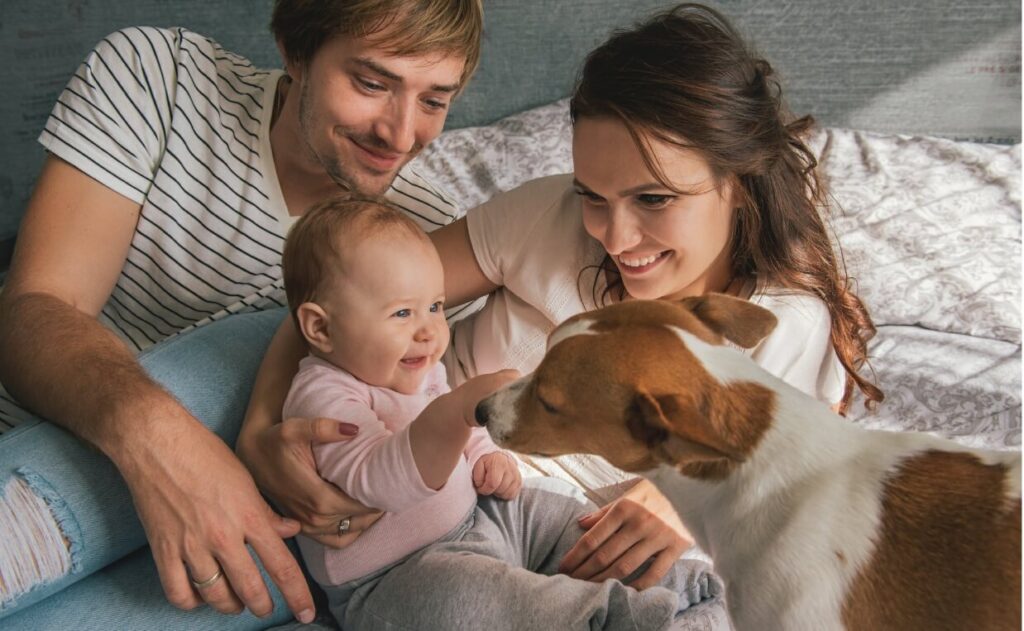The arrival of a new baby is one of the most exciting milestones in a family’s life, but it can also bring about significant changes for your furry friend. Pets, particularly dogs and cats, are often an integral part of the family, and their world can be turned upside down with the introduction of a new baby. The sounds, smells, and routine changes can be overwhelming for your pet, so it’s crucial to help them adjust in a calm and positive way.
Introducing your pet to a new baby requires patience, planning, and sensitivity to the needs of both your baby and your pet. By taking the right steps, you can ensure a smooth transition that makes everyone feel comfortable and secure. Here are some tips for introducing your pet to your new baby in the best way possible.
1. Prepare Your Pet Before the Baby Arrives
Preparation is key when it comes to introducing your pet to a new baby. Before your baby arrives, you should start setting the stage for the changes your pet will experience.
- Change in Routine: Pets thrive on routine, so try to gradually adjust their daily schedule well in advance of the baby’s arrival. This can include adjusting feeding times, walks, and playtime to align more with what the new routine will look like once the baby arrives. This will reduce the shock of a sudden change.
- Create a Baby-Free Zone: Set up a designated space in your home where your pet can retreat to if they feel overwhelmed by the baby. This area should be a place where they can relax and feel safe without being disturbed. If you have a dog, a crate or a quiet room works well for this purpose. If you have a cat, make sure they have access to their favorite spot or a quiet area away from the baby.
- Start with Baby Sounds and Smells: Gradually introduce your pet to the sights, sounds, and smells associated with a baby. Play recordings of baby sounds (crying, cooing, etc.) to help them get used to the noise. You can also place some baby lotions, baby powder, or other items in your home to familiarize your pet with the new scents.
2. Let Your Pet Get Used to Baby Gear
Before your baby arrives, set up the nursery and baby gear—such as cribs, strollers, high chairs, and playpens—in your home. This allows your pet to become familiar with these new objects in the environment and reduces the chances of them being startled by them when the baby arrives.
- Allow Exploration: Let your pet explore the baby’s room, crib, stroller, and other baby-related items while they are empty. This will help your pet get used to the presence of these objects, and they’ll be less likely to feel threatened or confused when they see them filled with the baby.
- Positive Association: Whenever your pet interacts with baby items, make sure to associate those experiences with positive reinforcement. Give your pet treats, praise, or extra attention when they approach or explore baby gear. This will help them associate the new items with pleasant experiences.
3. Introduce Your Pet to the Baby Slowly
When your baby arrives home, it’s important to introduce them to your pet in a calm, controlled manner. Keep in mind that your pet might be curious, excited, or even a bit anxious around the baby. Here’s how to manage the first meeting:
- Let Your Pet Scent the Baby First: Before any face-to-face introduction, let your pet get used to the baby’s scent. You can do this by having a family member bring a piece of the baby’s clothing (like a blanket or onesie) for your pet to sniff. This will help your pet become familiar with the baby’s scent before they interact directly.
- Stay Calm and Controlled: When it’s time for the first introduction, make sure your pet is calm and on a leash if necessary. Hold the baby securely in your arms, and allow your pet to approach at their own pace. Don’t force them to interact with the baby if they seem anxious—let the introduction happen gradually.
- Supervised Interactions: Always supervise any interactions between your pet and the baby, especially during the early stages. Babies may grab or poke at your pet, and it’s essential to monitor how your pet reacts to avoid any accidental injuries. Keep initial interactions short and positive, and gradually increase the time spent together as your pet becomes more comfortable.
4. Be Mindful of Your Pet’s Behavior
It’s natural for pets to feel a bit of jealousy or confusion when a new family member arrives. They might sense that their routine has changed, and they might not understand why they are receiving less attention. Here are some things to keep in mind:
- Maintain Special Time with Your Pet: While the baby will need a lot of your attention, make sure to set aside time for your pet each day. Whether it’s a walk, playtime, or cuddles, make sure they still feel loved and included in the family. This can help prevent behavioral issues such as separation anxiety or jealousy.
- Teach Your Pet Boundaries: Babies are naturally curious, and they might grab at your pet’s fur, tail, or ears. It’s important to teach your baby not to touch your pet roughly, but also to reinforce boundaries with your pet. For example, you can teach your dog to stay out of certain areas of the house when the baby is napping or help them learn that the baby’s toys are off-limits.
- Watch for Stress Signals: Keep an eye on your pet’s behavior and be aware of any signs of stress or anxiety. If your pet seems overly stressed, aggressive, or fearful, consider consulting with a professional animal behaviorist to help them adjust to the new family dynamic.
5. Safety First: Keep Your Baby Safe Around Pets
Safety is paramount when it comes to having both a pet and a baby in the same environment. Always prioritize the well-being of both your pet and your baby.
- Never Leave Your Pet and Baby Alone Together: Even the most well-behaved pets can be unpredictable, especially when they’re adjusting to a new situation. Always supervise interactions and never leave your baby and pet alone in a room together—especially in the early stages.
- Teach Your Baby About Pets: As your baby grows and starts to explore, begin teaching them how to interact with pets gently. Teach them not to pull on your pet’s fur, ears, or tail and encourage them to approach the pet calmly. While babies and toddlers may not fully understand these concepts right away, it’s important to start modeling respectful behavior early.
6. Give It Time: Patience is Key
It’s important to remember that both your pet and your baby are adjusting to a big change. The introduction of a new baby can take time, and your pet may need several weeks or months to fully acclimate to the new family dynamic. Be patient with your pet, and give them the space and time they need to adjust.
Consistency, patience, and positive reinforcement are essential throughout the process. With time, your pet and baby will learn to coexist peacefully, and you’ll be able to enjoy the bond between them as they grow together.
Conclusion: A Positive Transition for Everyone
Introducing your pet to your new baby doesn’t have to be a stressful experience. With careful preparation, patience, and gentle introductions, you can help ensure that both your pet and baby have a smooth transition into their new life together. By creating a positive environment, reinforcing good behavior, and fostering mutual respect, you can set the foundation for a lasting, loving relationship between your pet and your child. The journey may take time, but the rewards of seeing your baby and pet grow together as best friends are well worth the effort!

